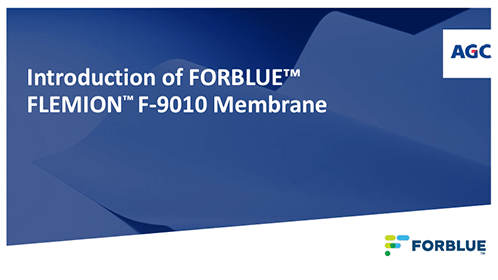-
AGC Chemicals Americas
-
 English
English
- Customer & product inquiries: 1-800-424-7833

FORBLUE™ FLEMION Ion Exchange Membranes
Fluorinated membranes are used to produce caustic soda/caustic potash in electrolysis plants.

FLEMION is a fluorinated ion exchange membrane that saves energy.
FORBLUE™ FLEMION fluorinated ion exchange membranes are used in electrolysis plants to produce caustic soda and caustic potash. FLEMION membranes deliver significant energy savings by minimizing electrical resistance and reducing the amount of electrical current required. In addition to improving energy efficiency, they help minimize the impact of brine impurities.
.
Used in salt electrolysis plants in over 50 countries all over the world
These membranes are used in the electrolyzers at electrolysis plants that decompose brine. They play a key part in manufacturing caustic soda (sodium hydroxide)/caustic potash (potassium hydroxide), chlorine, and hydrogen-basic chemical products. These chemicals are key ingredients of many products used in our daily lives.
FLEMION F-9060 is the latest grade. It works at a much lower voltage than F-9010 (-40mV versus 0mV) and features a higher CE and other performance improvements making it the most suitable option for Zero-Gap Electrolyzer operations.
AGC has continued its efforts to reduce electric resistance of ion exchange membranes over the last 40 years by applying innovative designs. FLEMION is a fluorinated cation exchange membrane that offers extremely low resistance and is the preferred product by many customers.

Markets
- Energy savings from low electric resistance
FLEMION fluorinated ion exchange membranes require low voltage at high DC current to decompose brine in an electrolyzer. Chlorine is generated at the anode, while sodium hydroxide (also called caustic soda) and hydrogen are generated at the cathode. Oxidation at the anode occurs simultaneously with reduction at the cathode, which makes current flow. The amount of energy consumed is a product of the voltage and current applied to the low power consumption results from the low resistance of the membrane. - High current efficiency
The electrical current efficiency is the ratio of the actual mass of a substance liberated from an electrolyte by the passage of current to the theoretical mass liberated according to Faraday's law. It is usually expressed as a percentage. A small part of hydroxide ions (OH-) generated on the cathode (negative side) of the electrolyzer passes through the cation exchange membrane to the anode side and cannot be collected as products. Reducing this part as much as possible increases the current efficiency. Our fluorinated cation exchange membrane for salt electrolysis has a carboxylic polymer layer which makes high electrical current efficiency. This fluorinated carboxylic polymer was developed by AGC to industrialize the membrane process of salt electrolysis. Now it is possible to keep electrical current efficiency high continuously. - Stable performance due to less impurity influence
The brine used for electrolysis includes impurities such as Ca and Mg that can negatively affect the performance of the membrane. For example, Ca reduces current efficiency while Mg increases voltage. FLEMION fluorinated ion exchange membranes minimize the influence of these impurities, enabling them to perform and remain stable longer.
- Electrolyzers in electrolysis plants
- Manufacturing caustic soda
- Manufacturing caustic potash
- Manufacturing chlorine
- Manufacturing hydrogen-basic chemical products
Click here to request an SDS sheet.
- Brine/membrane/raw salt analysis
- Salt titration
- Sample preparation
- History and record keeping
- Total organic carbon (TOC) testing
- Induced couple plasma (ICP) testing
- Ion chromatography (IC)
Contact our fluoropolymer experts to discuss your specific needs.
Latest from the Blog
FORBLUE™ Membranes for Chemical Separation
Chemical separation is used to isolate components of a substance for analysis, reclamation or purification. Separation methods include dialysis, electrolysis, filtration, evaporation, distillation and chromatography.
Read about this topic...Reducing Energy Costs During Salt Electrolysis with FLEMIONⓇ Fluorinated Ion Exchange Membranes
Caustic soda (sodium hydroxide), caustic potash (potassium hydroxide), chlorine, and hydrogen-basic chemical are critical ingredients used in products all over the world. These chemicals are used in a wide variety of household and industrial products including soaps, cleaners, and electrolytes…
Read about this topic...AGC Opens Lab to Service Chlor-Alkali Producers
AGC Chemicals Americas opened a 600+ square foot lab in Exton, Pennsylvania to provide brine/membrane testing services for our chlor-alkali producer customers.
Read about this topic...







